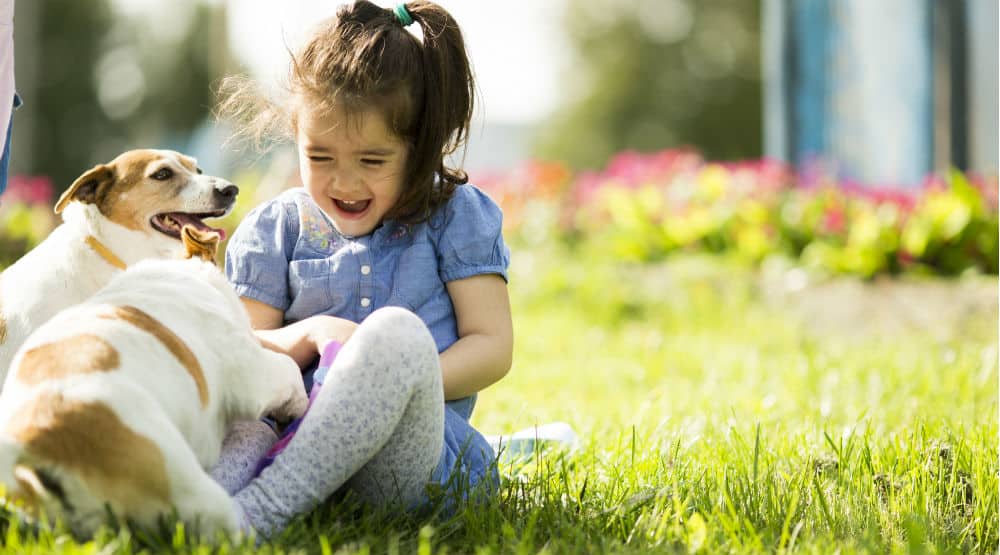Did you know that 68% of U.S. households have a pet and 89.7 million dogs live in these pet-loving homes? You don’t have to be a mathematician to understand that is a LOT of dogs!
Children up to age 18 live alongside these pets in many homes and what’s better than watching a child beam holding a newly adopted puppy or kitten? Kids and pet safety is important including a child safely holding their new best friend and learning the basics of how to interact and train the pet so that all family members can reap the benefits of pet ownership.
It’s been shown that kids develop much needed social skills with pet ownership including empathy, responsibility and patience. Because pets are a source of unconditional love, the affection, physical contact, and non-verbal communication between a child and pet can contribute to increased self-esteem.
Kids and Pet Safety Tips
Anyone who has owned a puppy knows that they explore their world, just as children do, and a critical window of development exists between the ages of 4 and 14 weeks. Most puppies are weaned from their moms and introduced to their forever home around 8 weeks of age. You have just a few short months to show your puppy that humans including children are safe, loving, and lots of fun to be around!
Even older dogs can bond with children in the home if they are approached and interacted with carefully and positively. The best people to teach small people how to interact with pets are big people. It’s possible and even likely that your two and four legged beasts can live harmoniously with kids and pet safety practices.
Children Under Four Years Old
Young children under 4 years of age don’t have social maturity, impulse control, and can be erratic in movement and behavior. The best advice for living with pets and preschoolers is to supervise every interaction. Give your pet a safe zone in which to retreat if a child’s hurried movements become overwhelming.
Introductions can be in a controlled, quiet environment while the pet is leashed. Model kindness and gentle, slow movements around pets who appreciate being “asked” if they can be stroked or picked up.
Like children, dogs appreciate predictability and structure. Even young puppies can be reliably taught to sit for a treat or other reward before being offered an outstretched hand to sniff; never reach over the head of the animal or hug a pet, both gestures can be perceived as threatening and lead to a bite.
Elementary School Age
Children can bear some of the responsibility of pet ownership once they have reached elementary school age. Teaching a child how to feed, groom and walk a dog helps establish the social hierarchy within the household.
We live by the adage “nothing in life is free” and children should give the pet a reward such as food, a toy, or attention if the dog sits and stays at their command. Pets can also be taught fun tricks like rolling over or playing dead.
Children should know that some items can be sacred to a pet. A dog may not take kindly to having their food dish taken or a favorite bone grabbed away. An adult should check to see if a dog has problems with food or territorial aggression before allowing the child to feed the pet. If a high-value item prompts an aggressive response in your dog when it is touched, get rid of it.
Startling a sleeping dog can also provoke a negative behavior; teach children to respect the pet’s space, don’t let your pet sleep on the bed, and let them be if they are asleep.
Best Dog Breeds For Kids
Is it possible to predict if a pet will be kid-friendly? In general, confident, not shy, dogs and puppies are best suited to homes with children. Loud noises startle some dogs more easily than others; those that are non-reactive to quick movements and the sound of a baby crying or a child’s high-pitched squeals adapt more easily to the hustle and bustle that accompanies large families.
Certain breeds are touted as being more family-friendly due to their physical sturdiness, patience, trainability, and love of attention. Retrievers, Boxers, lively Boston Terriers and Cavalier King Charles Spaniels are dog breeds that make excellent family pets.
Does the dog chase a fast-moving child? Growl when he’s approached while eating or lying on the bed? Pets can be desensitized to such actions but if given the choice, don’t set yourself up to fail. Older, arthritic pets may not be the best choice for families with young kids, nor dogs that did not grow up around children.
Puppies with few negative human experiences may be more amenable to positive training and reinforcement around behaviors typical of children. Give your puppy plenty of love, attention, or a food reward if they are calm and well-behaved around kids. Keep these kids and pet safety tips in mind. Pups soon learn to associate children with all the best things in life!

